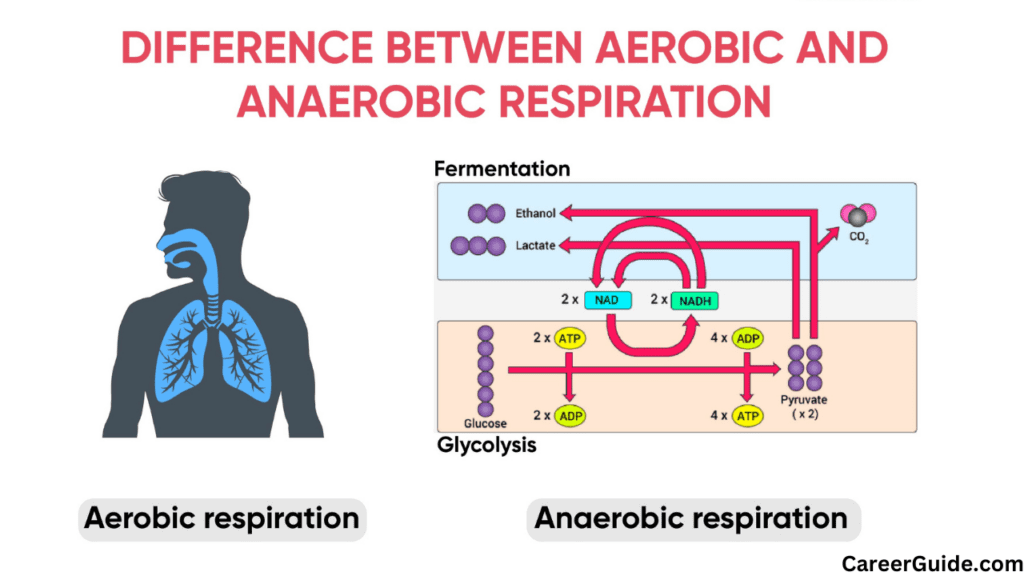To understand the difference b/w aerobic & anaerobic respiration, one must first know what it means. Aerobic respiration takes place in the presence of oxygen and is the most efficient way to produce energy. It occurs in the mitochondria of cells and produces 38 molecules of ATP, the cell’s energy currency, for every molecule of glucose that is broken down. Anaerobic respiration takes place in the absence of oxygen and is less efficient than aerobic respiration. It occurs in the cytoplasm of cells and produces 2 molecules of ATP per molecule of glucose.
Table of Contents
- The stages of aerobic and anaerobic respiration
- The role of enzymes in aerobic and anaerobic respiration
- The ATP yield of aerobic and anaerobic respiration
- The regulation of aerobic and anaerobic respiration
- The medical implications of aerobic and anaerobic respiration
- Frequently Asked Questions (FAQs)
The stages of aerobic and anaerobic respiration
Aerobic respiration
The stages of aerobic respiration are:
- Glycolysis: Glycolysis occurs in the cytoplasm of the cell and does not require oxygen. In glycolysis, one molecule of glucose is broken down into two molecules of pyruvate, producing a net gain of two ATP molecules.
- Pyruvate oxidation and the citric acid cycle: Pyruvate oxidation and the citric acid cycle occur in the mitochondria of the cell and require oxygen. In pyruvate oxidation, pyruvate is converted to acetyl coenzyme A (acetyl-CoA). Acetyl-CoA then enters the citric acid cycle, where it is completely broken down into carbon dioxide and water, releasing energy in the form of NADH and FADH2.
- Electron transport chain and oxidative phosphorylation: The electron transport chain and oxidative phosphorylation also occur in the mitochondria of the cell. In the electron transport chain, NADH and FADH2 donate electrons to a series of electron carriers. The electrons are eventually passed to oxygen, which produces water. As the electrons move through the electron transport chain, they pump protons across the inner mitochondrial membrane. This creates a proton gradient, which drives oxidative phosphorylation. In oxidative phosphorylation, ATP is produced as protons flow back across the inner mitochondrial membrane.
Anaerobic respiration
The stages of anaerobic respiration are:
- Glycolysis: Glycolysis is the same in both aerobic and anaerobic respiration.
- Fermentation: Fermentation occurs in the cytoplasm of the cell and does not require oxygen. In fermentation, pyruvate is converted to either lactic acid or ethanol, depending on the organism. Lactic acid fermentation is used by muscles during short bursts of intense activity, while alcoholic fermentation is used by yeast and bacteria to produce alcohol.

The role of enzymes in aerobic and anaerobic respiration
Aerobic respiration:
- Hexokinase: This enzyme catalyzes the first step of glycolysis, the phosphorylation of glucose.
- Pyruvate dehydrogenase: This enzyme converts pyruvate to acetyl-CoA, which then enters the citric acid cycle.
- Cytochrome c oxidase: This enzyme is the terminal electron acceptor in the electron transport chain. It catalyzes the transfer of electrons from cytochrome c to oxygen, producing water.
- ATP synthase: This enzyme couples the flow of protons across the inner mitochondrial membrane to the production of ATP.
Anaerobic respiration:
- Lactate dehydrogenase: This enzyme converts pyruvate to lactic acid in lactic acid fermentation.
- Pyruvate decarboxylase: This enzyme converts pyruvate to acetaldehyde in alcoholic fermentation.
The ATP yield of aerobic and anaerobic respiration
The theoretical maximum ATP yield of aerobic respiration is 38 molecules of ATP per molecule of glucose. However, in practice, the ATP yield is usually lower due to factors such as the inefficiencies of the electron transport chain and the use of ATP for other cellular processes.
Anaerobic respiration only produces 2 molecules of ATP per molecule of glucose. This is because anaerobic respiration does not use oxygen to break down glucose completely.
| Process | ATP yield per molecule of glucose |
|---|---|
| Aerobic respiration | 38 |
| Anaerobic respiration | 2 |
The regulation of aerobic and anaerobic respiration
The regulation of aerobic and anaerobic respiration is a complex process that involves many different factors, including oxygen levels, blood sugar levels, and hormone levels. The body carefully balances these factors to ensure that cells have the energy they need.
Here is a summary of the key points:
- Oxygen levels: When oxygen levels are high, the body favors aerobic respiration. When oxygen levels are low, the body switches to anaerobic respiration.
- Blood sugar levels: When blood sugar levels are high, the body releases the hormone insulin, which stimulates aerobic respiration. When blood sugar levels are low, the body releases the hormone glucagon, which also stimulates aerobic respiration.
- Hormone levels: Other hormones, such as adrenaline and cortisol, can also regulate aerobic and anaerobic respiration. These hormones are released in response to stress and exercise and prepare the body for physical activity by increasing the production of ATP.
The medical implications of aerobic and anaerobic respiration
Aerobic and anaerobic respiration are involved in a number of medical conditions, including:
- Exercise physiology: Aerobic respiration is essential for exercise performance. When you exercise, your muscles need more energy. Your body responds by increasing the production of ATP through aerobic respiration. The more efficient your aerobic respiration is, the better your exercise performance will be.
- Metabolic disorders: Metabolic disorders, such as diabetes and obesity, can disrupt the regulation of aerobic and anaerobic respiration. This can lead to a number of problems, such as fatigue, muscle weakness, and shortness of breath.
- Cancer: Cancer cells often have altered metabolism, including changes in aerobic and anaerobic respiration. This can make cancer cells more difficult to treat.
Frequently Asked Questions (FAQs)
Aerobic respiration is more efficient than anaerobic respiration because it produces more ATP per molecule of glucose.
Aerobic respiration takes place in the mitochondria of the cell.
Aerobic and anaerobic respiration are involved in a number of medical conditions, such as exercise physiology, metabolic disorders, and cancer.
The products of anaerobic respiration are carbon dioxide, lactic acid, or ethanol, and ATP.






